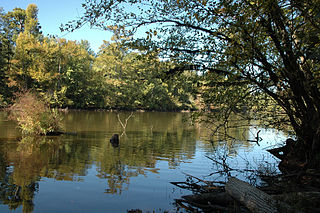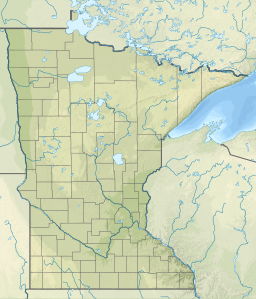
The St. Croix River is a tributary of the Mississippi River, approximately 169 miles (272 km) long, in the U.S. states of Wisconsin and Minnesota. The lower 125 miles (201 km) of the river form the border between Wisconsin and Minnesota. The river is a National Scenic Riverway under the protection of the National Park Service. A hydroelectric plant at the Saint Croix Falls Dam supplies power to the Minneapolis–St. Paul metropolitan area.

Lake Itasca is a small glacial lake, approximately 1.8 square miles in area. Located in southeastern Clearwater County, in the Headwaters area of north central Minnesota, it is notable for being the headwater of the Mississippi River. The lake is in Itasca State Park. It has an average depth of 20 to 35 feet and is 1,475 feet (450 m) above sea level.

Rock Creek is a tributary of the Potomac River, in the United States, that empties into the Atlantic Ocean via the Chesapeake Bay. The 32.6-mile (52.5 km) creek drains about 76.5 square miles (198 km2). Its final quarter-mile is affected by tides.

The Driftless Area, also known as Bluff Country, the Blufflands, the Paleozoic Plateau, and the Coulee Region, is a topographical and cultural region in the Midwestern United States that comprises southwestern Wisconsin, southeastern Minnesota, northeastern Iowa, and the extreme northwestern corner of Illinois. The Driftless Area is a USDA Level III Ecoregion: Ecoregion 52. The Driftless Area takes up a large portion of the Upper Midwest forest–savanna transition.

Savanna Portage State Park is a state park of Minnesota, USA, established in 1961 to preserve the historic Savanna Portage, a difficult 6-mile (9.7 km) trail connecting the watersheds of the Mississippi River and Lake Superior. The portage trail crosses a drainage divide separating the West Savanna River, which drains to the Mississippi River and the Gulf of Mexico, from the East Savanna River, which flows in an opposite direction to the Saint Louis River, Lake Superior and the Great Lakes, and the Saint Lawrence River to the Atlantic Ocean.

Wild River State Park is a state park of Minnesota, United States, curving along 18 miles (29 km) of the St. Croix River. This long, narrow park is shaped somewhat like a sideways 'S', with development largely concentrated in the lower third. The remote upper sections flank the mouth of a tributary called the Sunrise River. The park is managed to provide quieter, more nature-oriented recreation as a counterpoint to the busier William O'Brien and Interstate State Parks downstream.

Interstate Park comprises two adjacent state parks on the Minnesota–Wisconsin border, both named Interstate State Park. They straddle the Dalles of the St. Croix River, a deep basalt gorge with glacial potholes and other rock formations. The Wisconsin park is 1,330 acres (538 ha) and the Minnesota park is 298 acres (121 ha). The towns of Taylors Falls, Minnesota and St. Croix Falls, Wisconsin are adjacent to the park. Interstate Park is within the Saint Croix National Scenic Riverway and the Ice Age National Scientific Reserve. The western terminus of the Ice Age National Scenic Trail is on the Wisconsin side. On the Minnesota side, two areas contain National Park Service rustic style buildings and structures that are listed on the National Register of Historic Places.

Buffalo River State Park is a state park of Minnesota, United States, conserving a prairie bisected by the wooded banks of the Buffalo River. Together with the adjacent Bluestem Prairie Scientific and Natural Area co-owned by The Nature Conservancy and Minnesota's Department of Natural Resources, it protects one of the largest and highest-quality prairie remnants in Minnesota. It used to offer a man-made swimming pond close to the Fargo–Moorhead metropolitan area, however, that has not been open since 2018. Presently, it is most popular for its high quality educational programming, swimming in the Buffalo River, and picnicking. The 1,068-acre (432 ha) park is located just off U.S. Route 10 in Clay County, 4.5 miles (7.2 km) east of Glyndon and 14 miles (23 km) east of Moorhead.

The Little River is a tributary of the Red River, with a total length of 217 miles (349 km), 130 miles (210 km) within the Choctaw Indian Reservation in southeastern Oklahoma and 87 miles (140 km) in southwestern Arkansas in the United States. Via the Red, it is part of the watershed of the Mississippi River. Six large reservoirs impound the Little River and its tributaries. The drainage basin of the river totals 4,204 square miles (10,890 km2), 2,204 square miles (5,710 km2) in Oklahoma and 2,036 square miles (5,270 km2) in Arkansas. The Little River and its upper tributaries are popular for recreational canoeing and kayaking.
Screech Lake is a 16-acre lake in Cook County, Minnesota, which is a tributary to the Poplar River. Water clarity surveys performed by the University of Minnesota indicated Screech Lake had a visibility of 1.36 meters in 2008, although earlier surveys have yielded values of nearly 5 meters.
Corny Lake is an 11-acre lake in Cook County, Minnesota which is a tributary to the Poplar River.
Iowa Lake is a 30-acre lake in Cook County, Minnesota which is a tributary to the Poplar River. It has a maximum depth of 13 feet and is clear down to 7 feet. Water access is provided by a portage trail leading to its northeast shore. The lake is fed primarily by a stream on its northwest shore, with secondary intake coming from a pond of less than 100 feet to the north and an intermittent stream located to the south of the portage trail. Its outlet, on the south, empties into Corny Lake through a wetland area. A 1972 survey by Minnesota's DNR indicated the presence of a beaver lodge on the south outlet, and multiple beaver dams along the course of the creek have converted patches of the marsh into open water. A 1971 survey by the fisheries department indicated the lake was home to populations of northern pike, white sucker, and yellow perch.
Manymoon Lake is a 24-acre lake in Cook County, Minnesota belonging to the Poplar River watershed. At its deepest point it measures only 6.5 feet deep and has abundant aquatic plant life to a depth of 2.5 feet. Water clarity as of 2008 measured 1.41 meters. The substrate consists of muck and stones of no uniform size. Manymoon lake has neither inlet nor permanent outlet, although an intermittent stream feeds a wetland on the end of the southeastern bay. Nonetheless, Manymoon is located in the sub-watershed dominated by Rice Lake to the north, and water from Manymoon enters into lower portions of the Poplar River through Rice Lake's outflow. Manymoon is accessible through a portage off Rice Lake Road.
Tack Lake is a 16-acre lake in Cook County, Minnesota which is a tributary to the Poplar River through Rice Lake. Water clarity surveys performed by the University of Minnesota indicated Tack Lake had a visibility of 2.48 meters in 2008.
Silver Lake is a 22-acre lake in Cook County, Minnesota which is a tributary to the Poplar River. Silver Lake is six feet deep and has clarity down to 4.5 feet. It has one inflow from Bulge Lake, and drains into Rice Lake South of the inflow on the northwest shore, most of the west shore is a brush bog. Silver Lake has a shoreline of 1.1 miles.
Bulge Lake is a 12-acre lake in Cook County, Minnesota which is a tributary to the Poplar River. Bulge Lake reaches a maximum depth of 19 feet in a sudden depression just west of the mouth of the stream leading to Dogtrot Lake. Bulge lake is accessible through portages to Silver Lake and Dogtrot Lake. A fisheries survey turned up populations of walleye, northern pike, yellow perch, and white suckers.
Dogtrot Lake is a 15-acre lake in Cook County, Minnesota which is a tributary to the Poplar River. Dogtrot Lake reaches a maximum depth of 24 feet in a depression just south of the mouth of the stream leading to Slip Lake. Dogtrot lake is accessible through portages to Bulge Lake and Slip Lake. A fisheries survey turned up populations of walleye, northern pike, yellow perch, and white suckers.
Slip Lake is a 22-acre lake in Cook County, Minnesota which is a tributary to the Poplar River. Slip Lake reaches a maximum depth of 18 feet in a depression just south of the mouth of the stream leading to Fleck Lake. Slip Lake is accessible through portages to Dogtrot Lake and Fleck Lake. A fisheries survey turned up populations of walleye, northern pike, yellow perch, and white suckers.
Bouder Lake is a 129 acres (52 ha) lake in Cook County, Minnesota and a tributary of the Poplar River. Bouder Lake reaches a maximum depth of 17 feet (5.2 m). Bouder is accessible through a navigable channel leading into Crescent Lake. A fisheries survey turned up populations of walleye, muskellunge, smallmouth bass, yellow perch, and white suckers. An aquatic plants survey found the lake to be home to several species of water marigolds, pondweed, bladderwort, water lily, burreed, sedges, and cattails.
Lichen Lake is a 276-acre lake in Cook County, Minnesota which is a tributary to the Poplar River. It sits 1781 feet above sea level. Lichen Lake previously also went by the name Beaver Lake, but was formally affirmed in the present name in 1959 by the United States Board on Geographic Names.









